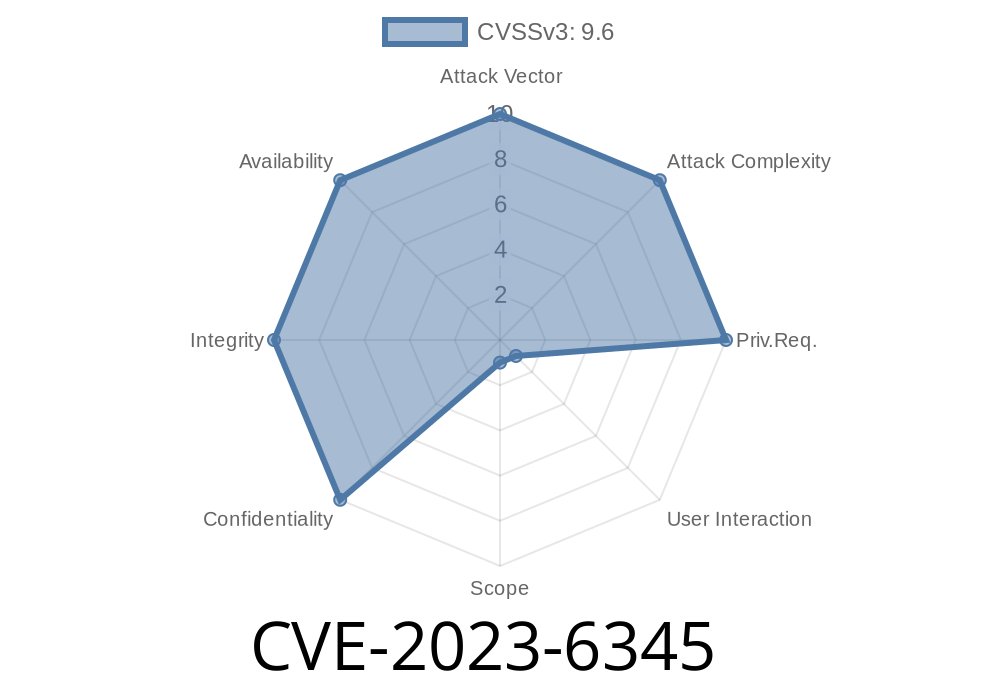CVE-2023-6345 refers to a recent vulnerability discovered in Google Chrome's Skia library, which affects versions of Chrome prior to 119..6045.199. This vulnerability is classified as an integer overflow, and it presents a threat whereby a remote attacker who has already compromised the renderer process of Chrome can potentially perform a sandbox escape using a malicious file. This post will discuss the specifics of the vulnerability, provide code snippets for better understanding, and share links to original references.
Vulnerability Details
The Skia library is an open-source graphics library used by Chrome, Android, and multiple other applications for drawing various graphics and images. CVE-2023-6345 targets an integer overflow vulnerability in Skia, which can ultimately be used by a malicious actor to break out of Chrome's sandbox, a security mechanism designed to keep applications and processes isolated, preventing unauthorized access or data leakage.
The Chromium team has labeled the security severity of this vulnerability as "High," indicating the considerable risk it poses. Exploiting this vulnerability requires a compromised renderer process, meaning the attacker has already achieved partial control over the browser, and the integer overflow exploit can escalate this access further.
Code Snippet Example
To help demonstrate the nature of this integer overflow vulnerability, consider the following simplified code snippet. While not the actual code used within Skia, this example will assist in understanding the core issue.
#include <iostream>
#include <cstdint>
int main() {
uint32_t width = xFFFF; // Width of an image, max value
uint32_t height = xFFFF; // Height of an image, max value
uint32_t pixel_format = 4; // Pixel format, 4 bytes per pixel (e.g., ARGB)
uint64_t memory_size = (uint64_t)width * height * pixel_format; // Calculate the total memory footprint
if (memory_size > UINT32_MAX) { // Check for overflow
std::cout << "Error: Integer overflow occurred!" << std::endl;
return 1;
}
std::cout << "Memory allocation size: " << memory_size << " bytes" << std::endl;
return ;
}
The code above demonstrates how an integer overflow can occur by multiplying the width, height, and pixel format variables. If the product of these values exceeds the maximum size of a 32-bit unsigned integer (UINT32_MAX), we'd have an integer overflow scenario.
Original References
The Chromium project has published their advisory with brief information about the vulnerability at the following link:
- Chromium Advisory for CVE-2023-6345
In addition, Google has rewarded the researcher who discovered the vulnerability, helping developers patch the issue and protect users. More information can be found at the following link:
- Google Bug Bounty Program
Mitigation and Exploit
Users are advised to update their Google Chrome browser to version 119..6045.199 or later, as this version contains the appropriate fix for this vulnerability. Doing so will prevent attackers from exploiting the sandbox escape and compromising the security of the user's system.
As the vulnerability is relatively new, proof-of-concept (PoC) exploits or in-the-wild exploits have not been publicly shared or observed. However, the necessity in updating to the latest Chrome version to defend against potential attacks is unquestionably important.
Conclusion
CVE-2023-6345 highlights the importance of continuous updates and proper patch management for various software tools and applications. While Chrome's automatic update mechanism makes it easier for most users to stay up-to-date, it is crucial to ensure that security updates are applied in a timely manner to avoid exposure to potential threats.
Timeline
Published on: 11/29/2023 12:15:07 UTC
Last modified on: 12/05/2023 17:15:08 UTC
